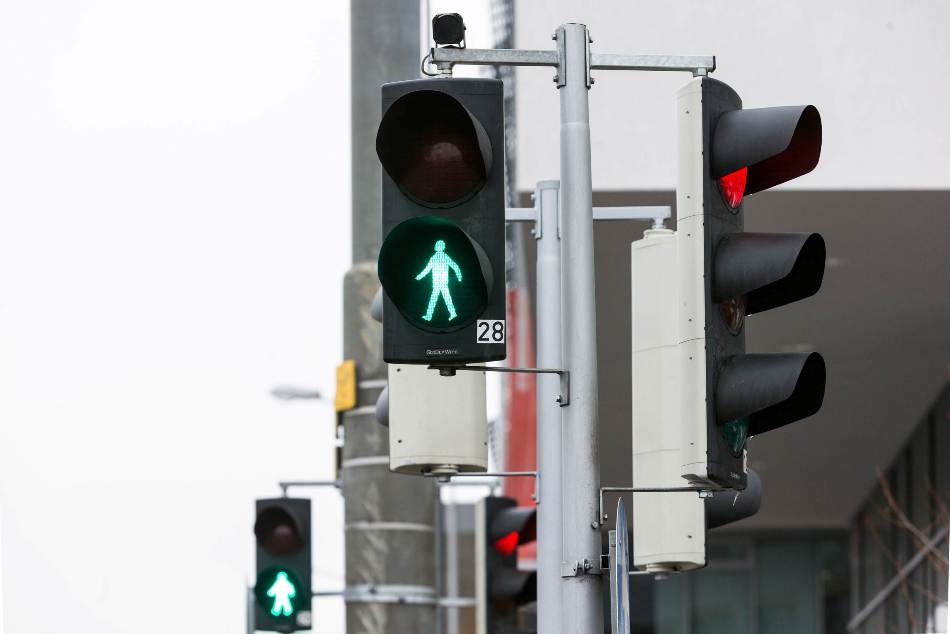May 28 2019
In Vienna, about 200 push-button pedestrian lights (signalized pedestrian crossings) are present. They enable pedestrians to safely get across a street. But they will have to wait for some time, which is infuriating for a number of people. This frequently causes pedestrians to not wait for the green phase, but rather walking in a different direction or crossing the road when the lights are red. For certain people, push-button lights are an invitation to activate off the green phase as they walk past – simply for fun. Car drivers get really annoyed when they have to stop at the crossing even though no one is crossing the road.
 The innovative pedestrian traffic lights will be in use throughout Vienna from the end of 2020. (© Günther Pichler GmbH)
The innovative pedestrian traffic lights will be in use throughout Vienna from the end of 2020. (© Günther Pichler GmbH)
More convenience – less waiting time
In a project ordered by Municipal Department 33 of the City of Vienna – in charge of urban lighting, clocks, traffic lights, and public Wi-Fi nodes – scientists at TU Graz’s Institute of Computer Graphics and Vision have created a new pedestrian traffic light system over the last three years which is more suitable and meant to swap the push-button system. The advanced camera-based system detects the intention of pedestrians to cross the street and switches to green automatically. Moreover, it enhances the traffic flow further, as Horst Possegger from the Institute of Computer Graphics and Vision explains by using two examples: “The green phase can be extended in the case of large groups of persons, who require more time to cross the road. And if persons leave the waiting area before the lights have turned to green, this is also passed on to the lights. The traffic lights subsequently don’t switch to green and there are no unnecessary waiting times for motorised traffic.”
Camera tracking as basis
The central feature is a camera placed on each pedestrian traffic light. While regular industrial solutions just cover a visual field of two by three meters, this system observes persons within a field of eight by five meters. It identifies whoever wants to cross the street in seconds. “It requires one second to estimate the intention – after two seconds the estimation becomes reliable,” explains Possegger. Then, the system signals the wish to cross the street on behalf of one or more persons to the pedestrian light controller. The latter chooses when the lights should switch – similar to a traditional push-button system. “Using the current configurations, our system signals that wish to cross three to four seconds before the button is pushed,” says Possegger.
Horst Possegger realizes that this all sounds very basic, but “two years of intensive research were necessary due to the complexity of requirements.” The hardware had to be sufficiently big for a robust local computer, but at the same time quite small to be placed inside the switch box of the traffic lights. Efficiency and exactness was a key goal of the software. Besides, the traffic light was also fitted with a monitoring system which can report errors instantly.
This is a double safeguard. The system was developed in such a way that it can work round-the-clock even in a harsh environment and can also deal with voltage fluctuations.
Horst Possegger, Researcher, Institute of Computer Graphics and Vision, TU Graz
Using universal movement models and recorded data, the research team formed learning algorithms which identify pedestrians’ intention to cross the road.
Possegger dismisses any uncertainties about data protection. Although the image data are undeniably vital to detect pedestrians – including children and persons with buggies or umbrellas, the images are only examined locally and cannot be transferred away from the camera. The pedestrian traffic light system runs solely with geometric information from which it derives a potential wish to cross.
Implementation by the end of 2020
At present, knowledge transfer is happening from the scientists to Günther Pichler GmbH. The company is in charge of the installation in the Vienna city area and will swap push-button lights with the new camera system at designated locations by the end of 2020 for evaluation purposes.
This research subject is grounded in the Field of Expertise “Information, Communication & Computing”, one of the five strategic research foci at TU Graz.
Occlusion Geodesics for Online Multi-Object Tracking
Occlusion Geodesics for Online Multi-Object Tracking (Credit: Vimeo)